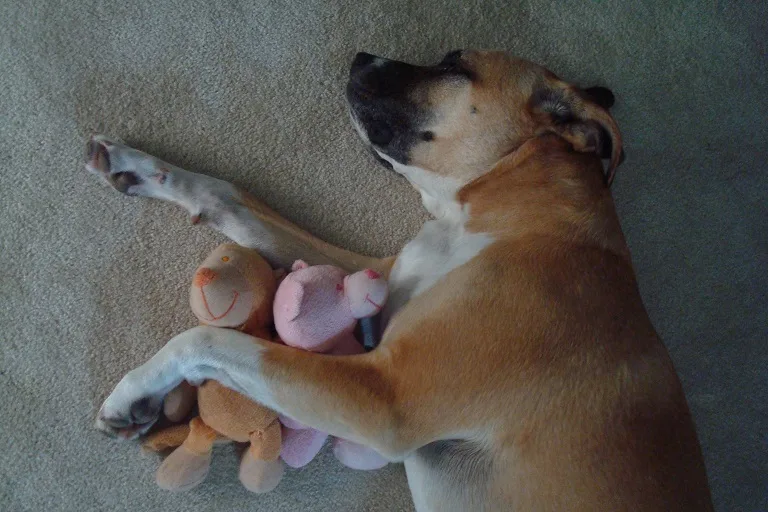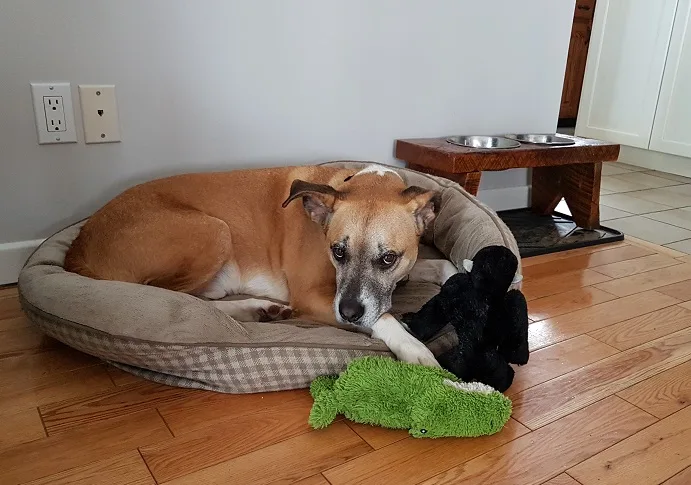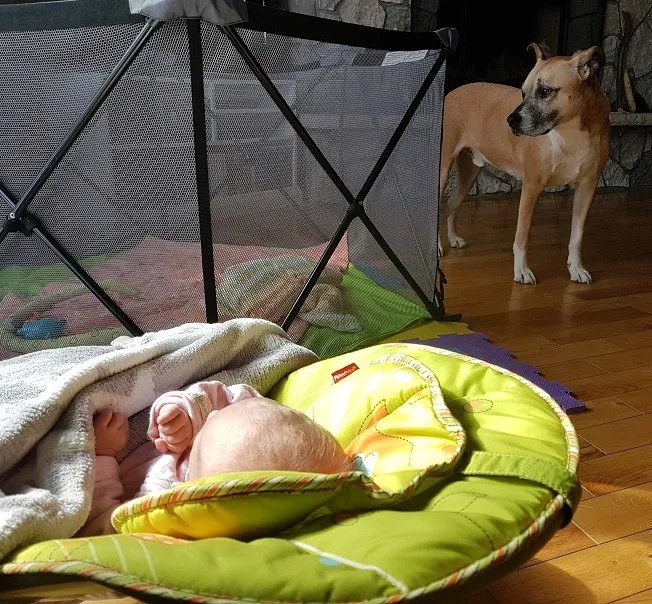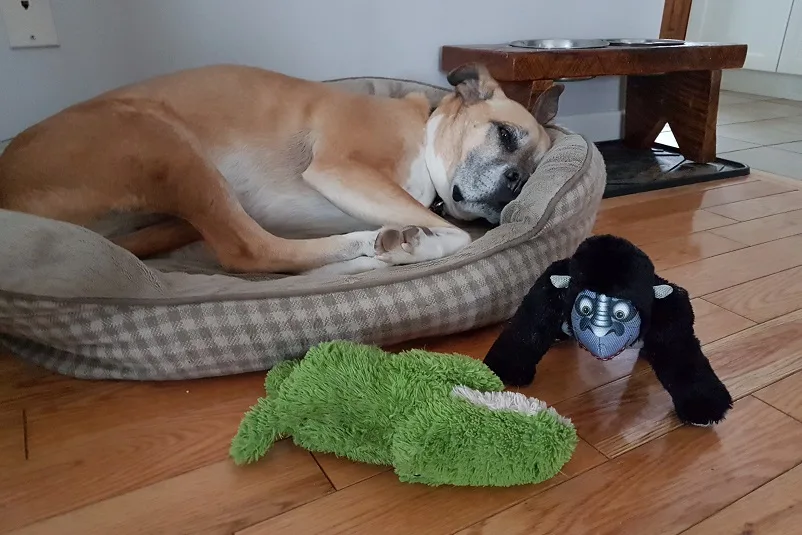It’s time for another post in our series of how I’m preparing my dog Baxter for the birth of our first baby. In today’s post I’m covering how we’re separating Baxter’s and baby’s toys. I’m also touching on resource guarding, as this can be a very challenging scenario for some dogs when it comes to toys.
A reminder that if you have serious behaviour concerns or special needs—resource guarding being a good example—our best advice is to work with a reputable, professional trainer.
I knew I was in trouble the day a friend dropped off a gift for our baby, and I pulled out a stuffed rabbit, held it out to my dog Baxter and said, “Look at the nice bunny for baby.”
Dude sniffed the nice bunny and then took it in his mouth, as he does with all new toys. Dumb move, Mama.
Fortunately, he gave up the bunny without a fuss. Up to now, any stuffed animals that have come into our house have been for Baxter, and they don’t look all that different from baby toys.

But all of a sudden, we have a new batch of stuffed toys. Toys that are off limits for Mr. B.
How to stop your dog from stealing baby toys
Baxter is very laid back and we are unlikely to have an issue with him stealing toys that belong to baby. However, every dog is different.
My strategy is to try to keep toys as separate as possible (easier while baby and her toys are small).
Baby’s toys will live in a few places: the nursery, baskets under the coffee table in the living room or in the corner of our basement family room, on the baby’s play mats or in the play yard.
Baxter’s toys live mostly in a basket under a chair in the family room and have for a long time. He knows where they are and will grab one if he wants to play. Usually we have two or three toys laying on the floor in both the family room and the living room.

I’m trying to remind myself to throw these toys into Baxter’s beds, or at least into the “baby-free zones” we’re establishing around his beds. As the baby grows, I’m hoping to teach her that those are Baxter’s toys and off limits. There will be no dog toys in the baby’s room.
My solution is not foolproof, and I’m sure there will be mix-ups, but we’re fortunate that Baxter is not possessive of his toys.
We’re also fortunate that baby’s other toys like hard plastic rattles or wooden blocks do not appeal to Bax. These types of toys can be dangerous to dogs if swallowed.
Teach your dog to ‘leave it’
For us, “leave it” or “can I have this?” works well if we need to retrieve items from Bax.
Some dogs may be reluctant to give up a toy once they have it in their possession. In those situations, commands that you may find helpful are “drop” or “not yours.” If your dog is at all reluctant to release a toy, condition him to giving up the toy by trading with higher value items, like a treat.
See our posts:
How to teach your dog to “drop”
How to teach your dog “leave it”
Resource guarding issues: How to stop your dog from guarding toys
Reluctance to drop a toy is usually different from resource guarding, which can be a very serious issue for some dogs, particularly when a child joins the house.
Resource guarding happens for a number of reasons, but it’s usually rooted in the dog being afraid of losing something he perceives as his (food, toy, bed, even a person).

One of the baby prep books that I read, “Please Don’t Bite the Baby” by Lisa J. Edwards, featured a dog with serious resource guarding issues. For her dog, Pinball, Edwards likened his resource guarding to hoarding in humans, in that it had an anxiety component.
She wrote, “Taking the object away forcibly most often increases the guarding and any aggressive response.” For this family, years of training had given them strategies for dealing with Pinball’s guarding, but it had not solved the issue.
Edwards started with treats and the “drop it” command. Eventually she added other commands until she had a “chain of behaviour” that helped Pinball relax and give up his prize.
She still continued to “pay” Pinball for objects he found particularly valuable or if he was particularly stressed. However, she claimed victory because “in most cases we have changed his emotional state regarding the loss of his resources.”
See our post: How to break a dog’s possessiveness
Resource guarding is serious and can be very dangerous. I recommend working with a professional trainer to address this issue. That way you can develop your own strategies for yourself, your child and your dog.

While a toy management strategy may be excessive for our laid back dog, for me it’s another step on our baby prep journey to ensure everyone respects each other and their things and we keep everyone safe and happy.
I hope we’re also able to help others in the process.
Have you ever dealt with possessiveness or resource guarding with your dog?
What are your tips for keeping baby and dog toys separate?
Let us know in the comments. Thank you!
Julia Thomson is a blogger at Home on 129 Acres where she writes about her adventures of country living and DIY renovating. She writes regularly for That Mutt.
Related posts:
How to stop your dog from guarding food or toys
First greeting between dog and baby

eli setiawan
Friday 4th of May 2018
hopefully these tips work, I will try to practice these tips
Julia at Home on 129 Acres
Friday 4th of May 2018
Try to be patient, consistent, calm and don't be afraid to ask for help. Good luck!
Pamela
Sunday 29th of April 2018
Terrific post. Wishing you luck that you can keep the toys separate in the middle of your busy life. But sounds like Baxter will do just fine.
I've founding teaching a good "leave it" crucial. We don't have children. But children frequently come up to greet Honey when we're out and about. It's a teaching moment to explain to them that their cupcake or ball or stuffy toy can be a big temptation to a dog.
Julia at Home on 129 Acres
Sunday 29th of April 2018
I love that you're teaching the children you meet as well as your dog. There are two sides in every relationship or interaction. I feel really strongly that we have to train both our dogs and our children.
Lindsay Stordahl
Sunday 29th of April 2018
Both my dogs are pretty into toys! Ace drops things because he's hopeful you'll throw it and play fetch. Remy can be very reluctant to drop items and this is very frustrating. Thankfully he does not get aggressive, he tenses up and clamps down on the item. It's really impossible to get it sometimes. Your reference with the anxiety component is exactly it. The more forceful we are, the worse it gets. I'll have to write about it sometime. We manage it just fine and have a few emergency tricks (throw food on the ground) but we haven't solved the actual issue.
Julia at Home on 129 Acres
Sunday 29th of April 2018
Having a few emergency tricks is a really good tip. It's so important that you've recognized Remy's anxiety. You have to know your dog and understand how to help him in these types of situations.